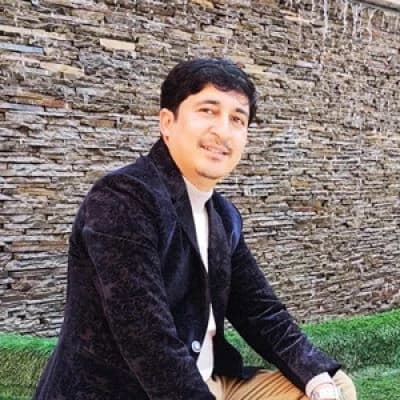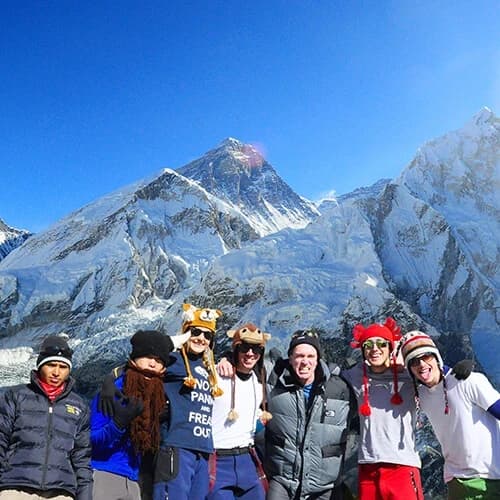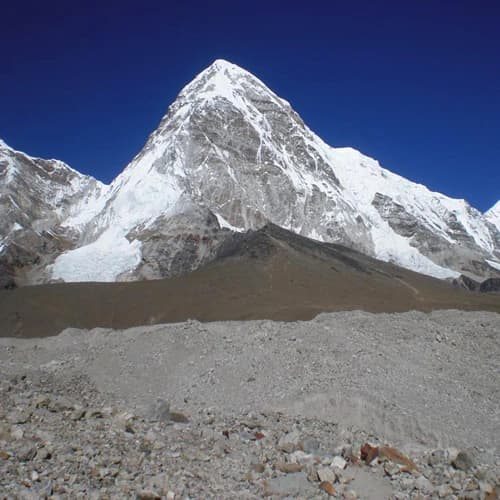Highlights of Trekking the Everest Base Camp in August
- Beautifully decorated flora, lush, verdant woodlands
- Clouds largely concealing the heat of the sun make for a wonderful trekking setting
- A breathtaking view of the mountains emerges when it's not raining
- Isolated routes provide you with complete privacy as you take in the surroundings
- More possibilities for lodging without the need for reservations in advance
- Lukla flights are readily available, albeit the weather may make flying challenging
- A challenging walk amidst monsoon for seasoned hikers
What's the Everest Base Camp Weather and Temperature like in August?
August is the off-season for trekking in the Everest region. Thus, fewer hikers are on the Everest Base Camp trail. The benefit is that there will be less traffic on the routes, allowing you to enjoy it alone in solitude. The only drawback to trekking in August is that you must be well-prepared for the weather because it's monsoon season.
August is the end month of the monsoon. Therefore, there is a good likelihood that you will experience heavy rain in the initial weeks. There will be fewer rainy days in the mid-weeks of August. Similarly, occasional rain is possible without a heavy downpour towards the end of the month. While light rain doesn't stop you from hiking, severe rain requires you to stop and seek shelter. That's why the last few weeks of August are the best time to start your monsoon adventure.
There are times when the vistas are better after rain than during other popular times of the year, like spring and autumn. It typically rains in the evening and at night in this Khumbu region (the local name for the Everest region). As a result, you will have the opportunity to experience beautiful vistas of the Himalayan snow-capped mountains in the morning when the clouds are clear. It's important to remember that precipitation occurs less frequently at higher elevations. Once you finish the first few days of the walk and get closer to Namche Bazaar (3440 meters), the risk of torrential rain lessens.
As the monsoon ends, you will experience hot and humid weather during the daytime. Similarly, the daytime temperature can go as high as 12 degrees Celsius, while the nighttime temperature can get as low as -5 degrees Celsius. This is the case for regions above 3500m altitudes. Likewise, for the lower altitude sections, the temperature can range between 8 to 18 degrees Celsius.
When the rain begins to pour, the temperature could drop significantly. It is advised to wear layers of clothing with a waterproof outer layer to stay warm and dry during rain. Wear a down jacket of superior quality to stay warm inside during the day. Bring a heavy sleeping bag to be warm and sleep soundly at night because the temperature may drop drastically.
You can also expect 6 to 7 hours of sunshine during the daytime, with some rainfall. Late afternoon and evening are frequently rainy, especially at lower altitudes. You will be safe if you set out on your hike early in the morning and complete it before the rainfall begins.
The average August wind speeds in the Everest region range from 5 mph (8 km/h) to 10 mph (16 km/h). The day is cozier, sunnier, and calmer than the night. It can get chilly in the evenings, so pack some warm apparel. You do need to realize that the weather in the Himalayas is unpredictable. But, it is always given that the weather can get freezing. Thus, it is always beneficial to carry your sleeping bags.
What are the Perks of Trekking to Everest Base Camp in August?
Since it is the off-season, August could only provide a few compelling reasons to visit EBC. But for committed explorers who want to experience the thrill that so few dares, this is the finest month. If you are drawn to the pristine glory of unspoiled nature, August is the best month to travel to the Everest region. Let's examine a few advantages of visiting Everest Base Camp in August.
Nature at its Best
The trails in August are lush and vibrant, teeming with the varying shades of green in the region. This is also when you enjoy the views of blooming flowers and wild berries decorating your trail with vivid colors. Similarly, the nearby water sources are also flowing at their full potential. And the sound of the rivers with the soft mellows of the birds combines and makes up for the challenging journey of your trek. As the hike takes you to the UNESCO-enlisted Sagarmatha National Park, you will enjoy traversing the unique vegetation. It is an experience many thrive for, but only you can make it possible!
Journey Full of Adventure
The August trek to Everest Base Camp offers the possibility of a wilderness experience. This is because the Everest region's scenery and climate in August are unmatched. The slick trail may require you to hike through the rain. The EBC trip, which is already a dangerous route, is even more thrilling by monsoon rain. You will go through some of the most challenging terrain in unreliable weather. To go on such a voyage, one must have guts. On the difficult August hike, people will be in awe of your bravery. Trekking in August is much more exciting than trekking during peak seasons when the weather is frequently favorable.
Less Crowd
As stated previously, August is an off-season trekking month in Nepal. You might be one of the few travelers on the trail. Since you won't frequently encounter other hikers, you might enjoy the trip in solitude. With few trekkers on the track, the path is considerably more peaceful. If you want to trek in solace away from the bustling of the busy trekking season, August is a perfect fit for you! The best thing is that you will experience the best of the wilderness without interference from other people. Think of hiking alone in a vast mountain range with no other people to impede your peaceful experience. Isn't it incredible?
More Facilities
As there will be few trekkers in the region's trekking route, there will also be few at the teahouse communities. So, you won't need to make any bookings for your stay, and you'll get to pick the best accommodations for yourself. During peak seasons, finding housing in the Everest region might be difficult. However, it seldom ever happens in August! Similarly, you will find it simpler to meet your needs because there will be a considerable decrease in the number of guests. But because there are fewer people around, most teahouses are closed then. Don't worry; there will be more than enough teahouses open in each village to accommodate all the trekkers, so there won't be a problem.
Festivals of August
Nepal is a culturally rich country with more than 123 different ethnicities living together in peace and harmony. So, you can get the flavor of festivals each month of your trip to Nepal. In August, you can look forward to the grand celebrations of Teej, Gai Jatra, Janai Purnima, and Krishna Janmashtami. All these festivals have some uniqueness to them with immense cultural significance. Thus, you will also experience the true essence of Nepali culture in August. If cultures and traditions intrigue you, you can schedule your trek to Nepal in August and enrich your travel experience even more.
Things of concern while trekking to EBC in August
- There can be landslide-prone areas at lower altitudes due to heavy rainfall.
- The track might be a little slick due to the rain this month. To keep yourself safe, use the proper footwear and take extra precautions.
- The lower frets can be crawling with leeches. Keep ointments and creams that are leech-repellent on hand.
- The Himalayan weather can be unpredictable, especially in the Everest region in August. Remember that you might have to extend your timetable by a few more days. The Lukla flight may be delayed or canceled due to bad weather.
- Be prepared in case a thunderstorm occurs.
Are trekking guides and potters essential for the August trek to EBC?
Unlike other trekking destinations, the Everest region authority does not compel tourists to hire a trekking guide. Therefore, you are free to embark on this trip alone. We wouldn't insist you hire a guide if the season were favorable. However, traveling in the Everest region out of season is extremely risky without a guide. Because of the awful weather, you won't even locate someone on the path to ask for anything you need. The linguistic barrier and the fact that you don't speak the language will make it difficult to perform simple tasks like finding the route. Therefore, we strongly suggest you travel with a knowledgeable guide on this challenging August excursion. Having a guide with you will make your walk more enjoyable and secure because they are adept at responding rapidly to hazardous weather conditions or medical emergencies.
The choice to hire porters is solely yours. You can even complete the journey without a porter if you are an accomplished hiker who has completed several high-altitude treks. However, porters make the journey noticeably more comfortable because they will carry most of your baggage from the beginning of the trip to its conclusion. The already tricky trekking terrain is made more difficult by the rain. A hefty backpack is dangerous to carry by yourself. Therefore, especially in August, we suggest hiring a porter.
Some Tips for Your August Trek to Everest Base Camp
- You have the option to travel solo, but due to the monsoon, it can get pretty risky. So, you must hire a guide.
- If you hire a porter, you do not have to exhaust yourself with unnecessary luggage carry.
- It's still monsoon in August; remember to carry rain gear.
- Check and double-check all your essential equipment.
- You will be trekking on foreign land, that too in the high Himalayas! So, only travel via a trustworthy and reputable trekking company.
- Every day before beginning the hike, check the weather forecast.
- You should set aside a few extra days because there is a potential that your flight to Lukla will be canceled, and you might need to deviate from your schedule because of heavy rain.
- Make sure your travel insurance is updated and that helicopter rescues are covered.
Packing List for July trek to EBC
- Rain gear (raincoat or rain cover or umbrella)
- Trekking shoes with sturdy soles
- Trekking socks and woolen socks
- Camp shoes (Sneakers or Sandals)
- Trekking poles
- Backpack and a day pack
- Thick sleeping bag
- Good quality down jacket and pants
- Waterproof windcheater jacket and pants
- Hiking T-shirts and pants
- Fleece jacket
- Thermal wear
- Extra clothes for layering
- Undergarments
- Woolen caps
- Gloves
- Basic First Aid Kit
- Water bottles with purifying pills
- Guide Book with a Trail map
- Toiletries
- Moisturizer
- Sunscreen
- Sun hat
- UV Sunglasses
- Protein bars
The monsoon season in Nepal generally lasts from June through August. It is, therefore, the country's wettest weather. It is also a time of year when the Nepalese Himalayas' foliage is decked in various shades of green. Even though it rains for the majority of the day, the situation is not as dire as it first appears. You're OK to go if you have rain gear like an umbrella and a raincoat with you. Monsoon trekking is a unique adventure in which only some people engage. But once you get rolling, this will surely rank among your most treasured experiences!
We hope we've clearly presented the situation in the Everest region during August. It is best to do proper research before embarking on the adventure to the Himalayas. And, in August, you got to be extra careful. Trekking to Everest Base Camp is possible all seasons of the year. However, it also depends on what features interests you. After all, you will dedicate your time, money, and effort to accomplishing the journey. If you love adventurous trekking, August is an incredible option for you. Trekking in August will surely get you those pumps of adrenaline rush you were eagerly waiting for.
If you're considering going on this excursion in August, keep Outfitter Nepal in mind. We will provide a highly-experienced guide to make the tour safe and enjoyable. We'll handle everything, including the flight trip to Lukla, the trekking permits, the stay, and the food while you're on the trail, so you won't have to worry about a thing. You can reach us via email or Whatsapp; we'll handle everything else. Enjoy your trek!
Some Most Popular Treks




